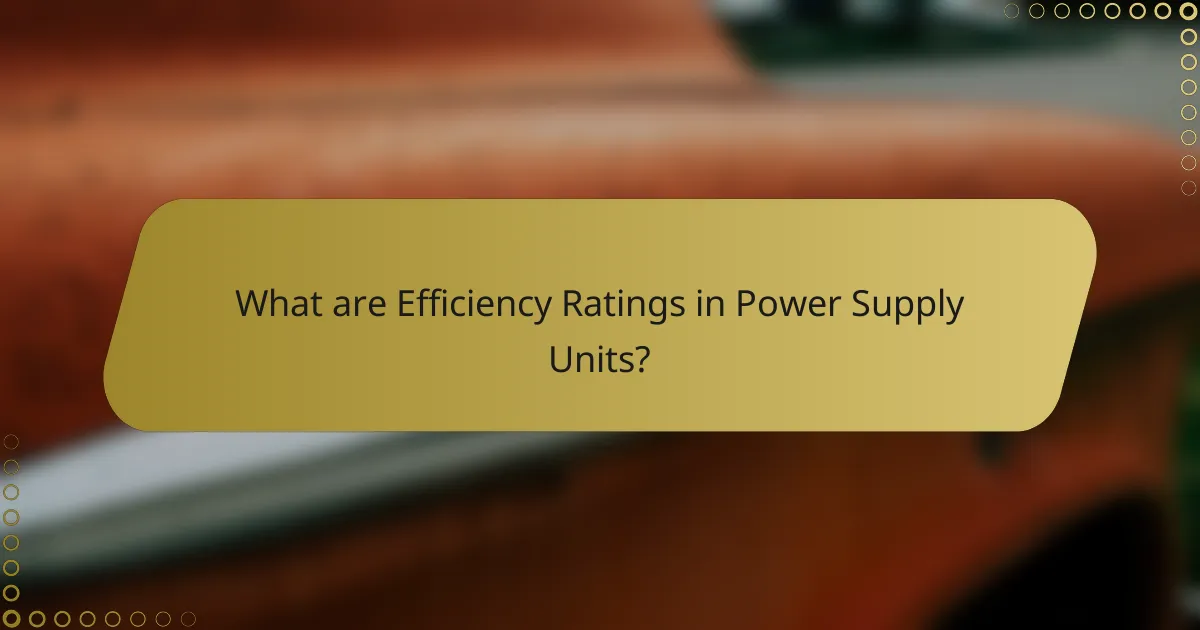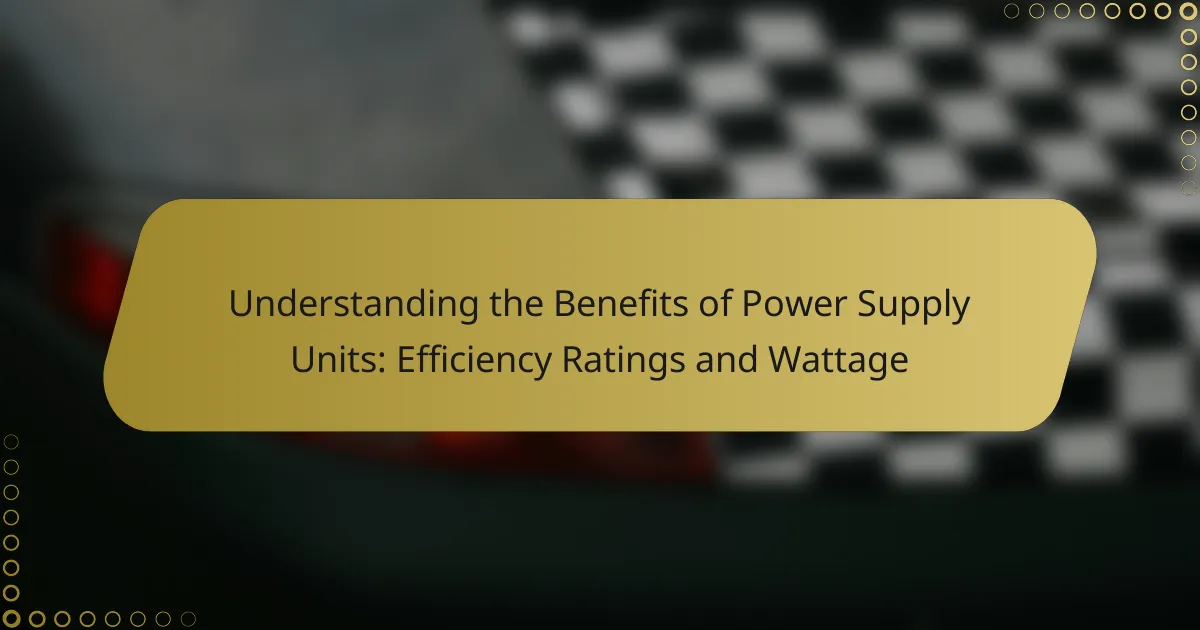Power Supply Units (PSUs) are critical components that convert electrical power from outlets into usable power for computers and electronic devices. This article explores the significance of PSUs, focusing on their efficiency ratings and wattage. Efficiency ratings, such as those defined by the 80 PLUS certification, indicate how effectively a PSU converts AC power to DC power, impacting energy consumption and costs. Additionally, the wattage rating of a PSU determines its maximum output capacity, which is essential for maintaining system stability and performance. Understanding these aspects of PSUs is vital for optimizing energy use and ensuring the longevity of electronic systems.

What are Power Supply Units and Why are They Important?
Power Supply Units (PSUs) are components that convert electrical power from an outlet into usable power for a computer or electronic device. They provide the necessary voltage and current to various components, ensuring stable operation. PSUs are important because they protect devices from power surges and ensure efficient energy use. A reliable PSU can improve system performance and longevity. Additionally, PSUs are rated for efficiency, which influences energy consumption and operational costs. High-efficiency PSUs can reduce electricity bills and environmental impact. Overall, the quality of a PSU directly affects the stability and reliability of the entire system.
How do Power Supply Units function?
Power Supply Units (PSUs) convert alternating current (AC) from the wall outlet into direct current (DC) for computer components. They regulate voltage levels to ensure stable power delivery. PSUs typically contain transformers, rectifiers, and capacitors. The transformer reduces voltage to the required levels. Rectifiers convert AC to DC, while capacitors smooth out fluctuations in the output. Most PSUs also include fans for cooling. The efficiency rating of a PSU indicates how much power is wasted as heat. A higher efficiency rating means better performance and lower electricity costs. For example, an 80 PLUS certified PSU is at least 80% efficient at various loads.
What are the essential components of a Power Supply Unit?
The essential components of a Power Supply Unit (PSU) include a transformer, rectifier, filter, and voltage regulator. The transformer converts high voltage AC to low voltage AC. The rectifier then converts the AC to DC. The filter smooths out the DC voltage. Finally, the voltage regulator ensures a stable output voltage. These components work together to provide reliable power to computer systems. Each component plays a crucial role in maintaining efficiency and performance.
How does the design of a Power Supply Unit impact its performance?
The design of a Power Supply Unit (PSU) significantly impacts its performance. A well-designed PSU enhances efficiency, reducing energy waste. It also stabilizes voltage output, preventing fluctuations that can harm connected components. The layout of internal components affects heat dissipation, influencing overall reliability. High-quality capacitors and inductors improve power delivery and reduce ripple voltage. Additionally, modular designs allow for better airflow and easier cable management. Studies show that PSUs with higher efficiency ratings, like 80 PLUS certifications, contribute to lower electricity costs. Overall, the design directly correlates with performance metrics such as efficiency, stability, and longevity.
What are the key benefits of using Power Supply Units?
Power Supply Units (PSUs) provide several key benefits. They convert AC power from the wall into usable DC power for computer components. This conversion ensures that devices receive the correct voltage and current. PSUs also improve energy efficiency, reducing electricity costs. A high-quality PSU can enhance system stability and reliability. Additionally, they protect components from power surges and fluctuations. Many PSUs include features like modular cables for better airflow. They are essential for supporting high-performance hardware, such as graphics cards. Overall, PSUs play a critical role in the functionality and longevity of electronic systems.
How do Power Supply Units enhance system reliability?
Power Supply Units (PSUs) enhance system reliability by providing stable and consistent power to computer components. They regulate voltage levels, ensuring that hardware receives the appropriate amount of electricity. This regulation prevents damage from power surges or fluctuations. Additionally, high-quality PSUs include features like overcurrent protection and thermal shutdown. These features safeguard components from electrical failures. A reliable PSU can also improve overall system performance by minimizing power loss. Studies show that systems with quality PSUs experience fewer hardware failures. This results in reduced downtime and maintenance costs for users.
What role do Power Supply Units play in energy efficiency?
Power Supply Units (PSUs) play a critical role in energy efficiency by converting electrical power from a wall outlet into usable power for computer components. They determine how effectively this conversion occurs, impacting overall energy consumption. High-efficiency PSUs, rated 80 Plus or higher, waste less energy as heat. This means more power is available for the system’s operation and less is lost during the conversion process. According to the U.S. Department of Energy, using efficient PSUs can reduce energy costs significantly over time. Therefore, selecting a PSU with a high efficiency rating directly contributes to lower electricity bills and reduced environmental impact.

What are Efficiency Ratings in Power Supply Units?
Efficiency ratings in power supply units (PSUs) indicate how effectively a PSU converts AC power from the wall into DC power for computer components. These ratings are expressed as percentages, showing the ratio of usable power output to the total power input. For example, a PSU with an 80% efficiency rating converts 80% of the input power into usable output, while 20% is lost as heat. Common efficiency standards include 80 PLUS, which sets benchmarks for various efficiency levels such as Bronze, Silver, Gold, Platinum, and Titanium. Higher efficiency ratings typically result in lower energy costs and reduced heat generation. According to the 80 PLUS certification program, PSUs with higher ratings can save users significant amounts on electricity over time.
How are Efficiency Ratings determined?
Efficiency Ratings are determined through standardized testing of power supply units (PSUs). These tests measure the ratio of output power to input power under various load conditions. The results indicate how effectively a PSU converts AC power from the wall into DC power for components. The most recognized standards for this testing include 80 PLUS certification. This certification requires a minimum efficiency threshold at specified loads, such as 20%, 50%, and 100%. For example, a PSU must achieve at least 80% efficiency at 20% and 100% loads to qualify. Higher ratings, like 80 PLUS Gold or Platinum, require even greater efficiency levels. This systematic evaluation ensures consumers can trust the efficiency claims of PSUs.
What are the different categories of Efficiency Ratings?
The different categories of Efficiency Ratings for power supply units are Bronze, Silver, Gold, Platinum, and Titanium. These categories indicate the energy efficiency of the units. For example, Bronze-rated units have a minimum efficiency of 82% at 20% and 100% load. Silver-rated units achieve at least 85% efficiency at the same loads. Gold-rated units must reach 87% efficiency at 20% and 100% loads. Platinum-rated units have a minimum of 90% efficiency at 20% and 100% loads. Finally, Titanium-rated units achieve at least 94% efficiency at 20% and 100% loads. These ratings help consumers identify the energy efficiency of power supply units, promoting better energy use and cost savings.
How do Efficiency Ratings affect operational costs?
Efficiency ratings directly influence operational costs by determining the energy consumption of power supply units. Higher efficiency ratings mean that less energy is wasted as heat. This translates to lower electricity bills over time. For example, a power supply unit with an 80% efficiency rating wastes 20% of energy, while a unit with a 90% rating only wastes 10%.
According to the U.S. Department of Energy, improving efficiency by just 5% can lead to significant savings in energy costs. In commercial settings, these savings can amount to thousands of dollars annually. Therefore, investing in power supply units with higher efficiency ratings can substantially reduce long-term operational costs.
Why is it important to consider Efficiency Ratings when selecting a Power Supply Unit?
Efficiency ratings are crucial when selecting a Power Supply Unit (PSU) because they indicate how effectively the unit converts AC power from the wall into DC power for the computer. A higher efficiency rating means less energy is wasted as heat, leading to lower electricity bills and improved system stability. For example, a PSU with an 80 Plus certification guarantees at least 80% efficiency at various load levels. This efficiency not only reduces operational costs but also contributes to a cooler and quieter system, as less heat generation requires less cooling. Additionally, high-efficiency PSUs often have better components and build quality, enhancing reliability and longevity. Therefore, considering efficiency ratings is essential for optimizing performance and cost-effectiveness in power supply selection.
How does a higher Efficiency Rating benefit users?
A higher Efficiency Rating benefits users by reducing energy consumption. This leads to lower electricity bills over time. Efficient power supply units convert more input power into usable output power. For example, a unit with an 80% efficiency rating wastes 20% of energy, while a 90% rating wastes only 10%. This efficiency can significantly decrease heat generation. Less heat means improved reliability and longevity of the power supply unit. Additionally, users contribute to environmental sustainability by using less energy. Overall, a higher Efficiency Rating translates to cost savings and enhanced performance.
What are the implications of low Efficiency Ratings?
Low Efficiency Ratings in power supply units indicate wasted energy and increased operational costs. These ratings reflect how effectively a unit converts input power into usable output power. A low rating means more energy is lost as heat. This inefficiency can lead to higher electricity bills for consumers. Additionally, it can result in higher cooling costs due to excess heat generation. Furthermore, low efficiency can shorten the lifespan of the power supply unit. Inefficient units may also contribute to a larger carbon footprint. Therefore, low Efficiency Ratings have significant financial and environmental implications.

What is Wattage and How Does it Relate to Power Supply Units?
Wattage is a measure of electrical power expressed in watts. It quantifies the rate at which energy is consumed or produced. Power supply units (PSUs) convert electrical energy from a source into usable power for computer components. The wattage rating of a PSU indicates its maximum output capacity. For example, a 500-watt PSU can supply up to 500 watts of power to components. This rating is crucial for ensuring that the PSU can adequately support the power requirements of all connected devices. Insufficient wattage may lead to system instability or hardware failure. Therefore, selecting a PSU with appropriate wattage is essential for optimal performance.
How is Wattage calculated in Power Supply Units?
Wattage in Power Supply Units (PSUs) is calculated using the formula: Watts = Volts × Amperes. This formula measures the electrical power output of the PSU. Voltage is the electrical potential difference, while amperage represents the current flowing.
For example, if a PSU outputs 12 volts and 5 amperes, the wattage is calculated as 12 × 5, resulting in 60 watts. This calculation is crucial for determining the PSU’s capability to power components. Accurate wattage helps ensure that the PSU can support the total power requirements of a computer system.
What factors influence the Wattage of a Power Supply Unit?
The wattage of a power supply unit (PSU) is influenced by several factors. These factors include the components connected to the PSU, such as the CPU and GPU. High-performance components require more power, increasing the PSU’s wattage needs. The efficiency rating of the PSU also plays a role. Higher efficiency ratings mean less power waste, potentially allowing for lower wattage. Additionally, the PSU’s design and quality affect its wattage output. A well-designed PSU can deliver consistent power even under load. Lastly, future upgrade considerations can influence the wattage choice. Users may select a higher wattage to accommodate potential future hardware upgrades.
How does Wattage impact system performance?
Wattage directly impacts system performance by determining the amount of power available to components. Higher wattage allows for more energy-intensive tasks and greater component stability. For example, a power supply unit rated at 750 watts can support high-performance graphics cards and multiple drives. Insufficient wattage can lead to system instability, crashes, or hardware damage. Research indicates that systems running on lower wattage than required may experience throttling, affecting overall performance. The efficiency of power supply units also plays a role; units with higher efficiency ratings convert more electricity into usable power. Thus, adequate wattage is essential for optimal system functionality and longevity.
What should you consider when choosing the appropriate Wattage for your needs?
When choosing the appropriate wattage for your needs, consider your device’s power requirements. Each component in your system has a specific wattage demand. For example, a typical gaming PC may require between 500 to 850 watts. Check the manufacturer’s specifications for each component. This information is often found in the product manual or on the manufacturer’s website. Additionally, consider future upgrades when selecting wattage. A higher wattage supply allows for additional components without exceeding capacity. It’s also essential to account for efficiency ratings. Power supply units (PSUs) with higher efficiency ratings waste less energy and produce less heat. Finally, ensure the PSU has adequate connectors for your components. This ensures compatibility and optimal performance.
How can you determine the Wattage requirements for your system?
To determine the wattage requirements for your system, first, identify all components that require power. This includes the CPU, GPU, motherboard, RAM, storage devices, and any peripherals. Next, check the specifications for each component to find their individual wattage consumption.
Add up the wattage values of all components to get the total wattage requirement. It is advisable to include an additional 20% to 30% margin for power supply efficiency and future upgrades. This ensures stable performance and longevity of the power supply unit.
For example, if the total calculated wattage is 400W, selecting a power supply rated between 480W and 520W would be ideal. This method provides a practical approach to ensuring that your system has adequate power.
What are common mistakes to avoid when selecting Wattage?
Common mistakes to avoid when selecting wattage include underestimating power requirements. Many users choose a power supply with insufficient wattage, leading to system instability. This can result in unexpected shutdowns or hardware damage. Overestimating wattage is another mistake. Selecting a power supply with excessive wattage can lead to inefficiencies. Users may also neglect to consider peak power demands. Some components require more power during startup than during normal operation. Failing to account for future upgrades is a frequent oversight. Users should select a power supply that accommodates potential increases in power needs. Lastly, ignoring the efficiency rating can lead to higher energy costs. A power supply with a higher efficiency rating will waste less energy.
What are the best practices for optimizing the performance of Power Supply Units?
To optimize the performance of Power Supply Units (PSUs), ensure proper ventilation and airflow. Adequate airflow prevents overheating, which can reduce efficiency. Use high-quality capacitors to enhance reliability and longevity. Selecting a PSU with an appropriate wattage rating is crucial. It should meet or slightly exceed the total power requirement of connected components. Regularly clean dust from the PSU and surrounding areas to maintain cooling efficiency. Monitor voltage levels to ensure they remain stable and within specifications. Lastly, consider using modular PSUs for better cable management, which can improve airflow and reduce clutter. These practices collectively contribute to maximizing PSU performance and reliability.
Power Supply Units (PSUs) are essential components that convert electrical power into usable energy for computers and electronic devices, ensuring stable operation and protecting against power surges. This article explores the significance of PSUs, focusing on their efficiency ratings and wattage, which directly impact energy consumption, operational costs, and overall system reliability. Key topics include the functioning of PSUs, the importance of efficiency ratings, how to calculate wattage requirements, and best practices for optimizing PSU performance. Understanding these aspects is crucial for selecting a high-quality PSU that enhances system performance and longevity.
